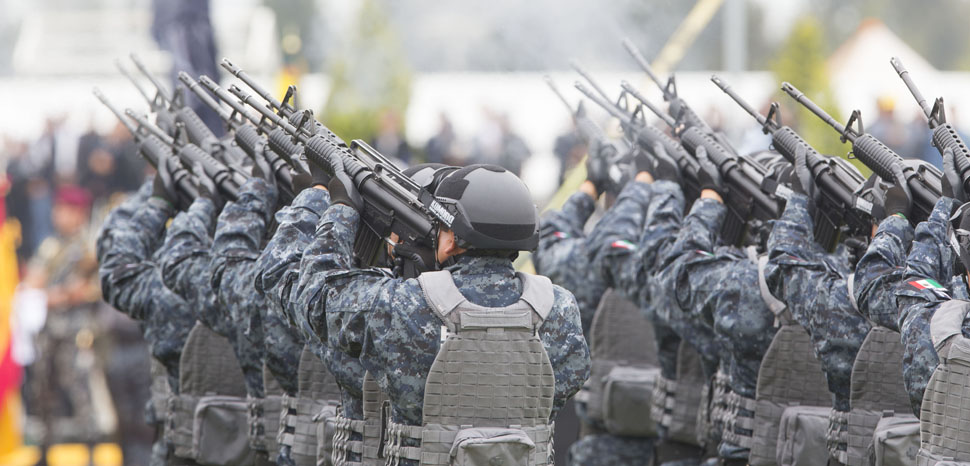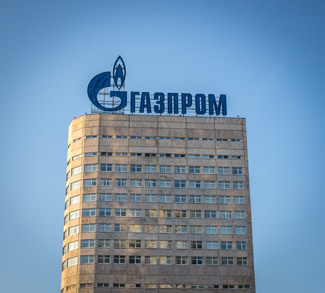For decades now, organized crime in Mexico has been constantly mentioned in headlines both in the country and abroad, mainly due to its increasing boldness, the broad scope of its actions and − above all − the shocking incidents of violence in which it is often involved. Hence, it is often portrayed as the leading protagonist in Mexico’s ongoing security crisis.
However, organized crime in Mexico is far a new phenomenon. Actually, armed gangs of rural bandits that operated in remote regions sprung up like mushrooms in the late 19th and early 20th centuries. During the chaos unleashed by the Mexican Revolution, looting of private property was commonplace and even trains were occasionally ambushed to steal their freight. Moreover, small cells of drug smugglers proliferated throughout the 20th century in states close to the US border.
Currently, Mexico is engulfed in a bloody and seemingly endless conflict that has two parallel dimensions. First, in a struggle to restore order, the security forces of the Mexican state are fighting paramilitary squads of drug cartels and other organized criminal groups, an effort that looks a lot like a protracted counterinsurgency campaign. Second, several criminal militias are fighting each other in order to increase their market share and monopolize illicit trades in their respective territories, a confrontation that is essentially an irregular war between non-state subnational actors. This situation is a good example of what the American professor Sean McFate calls “durable disorder,” i.e. intermittent clashes in unconventional battlefields in which there are no conclusive outcomes.
The origins and nature of these phenomena are often misunderstood. Some observers emphasize one single factor as the fundamental cause: impunity, corruption, and/or poverty. Others highlight the influence of human agency, especially the fateful decisions made by key individual players (including senior policymakers and drug lords). Both perspectives might offer some partial insight about specific circumstances or particular episodes but, in the grand scheme of things, their simplicity misses the big picture.
Monocausality is hardly useful; rather, a broader and deeper analytical viewpoint is needed to reveal the phenomenon’s high degree of complexity and how it has evolved in recent decades. Accordingly, the following sections offer a multidimensional understanding of how a combination of impersonal forces has shaped the transformation of Mexican organized crime.
Geopolitical Factors
In terms of internal geopolitics, Mexico is a fragmentary national state. It is a country littered with mountain ranges throughout, deserts in the north, and jungles in the southeast. Furthermore, it lacks a network of navigable rivers that favors political and economic interconnectedness. Under such conditions, it is difficult for the federal government and security forces − headquartered in Mexico City, the country’s heartland − to establish a strong presence in remote hinterland regions. Thus, effective governance and territorial control are notoriously challenging endeavors.
As a result, Mexico is an amalgam of regions whose geographic contexts, demographic profiles, historical backgrounds, economic dynamics, and cultural traits are highly heterogeneous. Hence, said conditions have given birth to powerful local entities, including political groups, business communities, and criminal networks. It is hardly surprising that agricultural fields for growing opium poppies or clandestine labs are frequently found in areas in which simply gaining access is a daunting task.
Accordingly, the prospects of cooperation or confrontation are largely defined by the prevailing contextual circumstances. When the central government is strong, it can ensure a reasonable degree of order but, when it is weak, centrifugal forces become the rule rather than the exception, a reality that has been historically reflected in the rise of local strongmen, separatist movements, subversive armed groups, and large drug cartels.
Concerning external geopolitics, it must be kept in mind that when the US closed the maritime flow of South American narcotics to Florida through the Caribbean Sea in the 80s, Mexico was positioned as the natural land bridge for transnational drug-trafficking operations from South American production zones to North American consumer markets.
For example, cocaine, an alkaloid that is extracted through chemical processes from the coca bush, is a plant that can only be grown in commercial volumes in countries from the Andean region − Colombia, Bolivia and Peru – due to their geography. A few decades ago, Mexican criminal groups were mostly the junior partners of their Colombian associates, but the geoeconomic readjustment of illicit drug flows altered this balance of power. As a result, in the new correlation of forces, South American criminal groups operate as suppliers for dominant Mexican cartels.
Moreover, due to its geographic situation, Mexico has ample access to firearms via the US market. Although legally bought and sold on US soil, the porous border and corruption makes it relatively easy to introduce them to Mexico, as shown in the so-called “Operation Fast and Furious”, covertly carried out by agencies of the Department of Justice during the Obama administration, allegedly to demonstrate how simple and widespread bilateral gunrunning had become.
Last but not least, Central America offers vast arsenals of American and Soviet weapons due to the conflicts that were fought there during the late Cold War. Since firearms are not perishable goods (handguns, assault rifles and ammo that were manufactured decades ago can be functional today), nowadays they still can be bought and sold in black markets. Even though most weapons used by Mexican criminal groups come from the United States, the porous border that separates Mexico from the Central American isthmus represents an alternative way to obtain weaponry.
Political Factors
After the Mexican Revolution, the winners established a hegemonic regime that managed to pacify the country and to consolidate it as a modern national state. In order to do that, the regime constructed an internal balance of power that was a functional mechanism to control different factions and keep underlying tensions in check, as well as to marginalize or coopt sources of non-conformity (some of which were motivated by legitimate concerns).
Far from being democratic, this system was authoritarian, but it was also pragmatic. For instance, when faced with discontent, the system offered concessions or compensations and only those that refused to reach a reasonable compromise through negotiations would be targeted with coercive measures. Moreover, the government mediated when disputes broke out between competing factions. On the other hand, the regime legitimized itself with the implementation of policies that fueled development and economic dynamism. Without the active intervention of the state in that period, Mexico would not be a manufacturer of industrial goods today.
As the dominant force, the state even organized social and economic actors in sectoral groups and collective institutional umbrellas that could be easily controlled, including business chambers, labor unions, industrialists, peasants, teachers and so on. They all had to play according to the rules established by the central government. Under this illiberal political framework, independent political and economic action was tolerated, as long as it did not interfere with the priorities and goals defined by the state. If anyone broke the rules, the state could employ co-option, intimidation, threats and − if necessary − repression. This singular arrangement minimized the risk of escalating socio-political conflicts and it also explains why Mexico never experienced a coup d’état like the ones that took place throughout Latin America in the 20th century.
Under such circumstances, organized crime groups − mostly involved in growing and trafficking marijuana back then − were treated just like any other sector. Their illicit businesses were tolerated, as long as they respected the supremacy of the state and did not operate very violently. An expression of this subordination was the payment of ‘fees’ (i.e. bribes) as some sort of taxation charged by both federal and local governments. Likewise, the state acted as the ultimate arbiter when there were disagreements amongst rival criminal groups.
Nevertheless, this system started to erode by the 70s due to growing popular demands, increasing discontent in various sectors (including the middle classes and the business community), economic stagnation, the heavy impact of external disruptions, and an appalling financial mismanagement.
In a quest to recover its legitimacy, protect stability, and preserve governance in an environment of chaos and uncertainty, the state decided to make political concessions and it undertook gradual democratic reforms that enabled the decentralization of power and the chance of fully autonomous political participation. This eventually led to the fateful political transition that occurred in 2000. After more than seven decades of uninterrupted rule, the Institutional Revolutionary Party (PRI) was defeated in free and fair elections and it handed power to the National Action Party (PAN). Mexico’s political life has been plural ever since.
Nevertheless, as its power receded, the state could no longer impose the system of checks and balances that had previously been in place. As a result, the central government became weaker and, since power voids are short-lived, other players that used to be under the central government’s control have had an incentive to pursue their interests in a more assertive way. Organized crime groups were amongst those actors.
As a result, all Mexican presidents since 2000 have faced a difficult dilemma. When the federal government and its security services − including armed forces, intelligence agencies, and law enforcement − engage organized crime in a full-frontal way, backlash and retaliation are common consequences. Moreover, beheading criminal organizations by arresting or ‘neutralizing’ their leaders triggers internal succession crises and power struggles, since several of their lieutenants are eager to replace their former bosses as soon as they are gone, which can lead to a fragmentation of criminal networks which rapidly turns violent. Moreover, when a criminal structure is successfully dismantled, the turf it used to hold becomes ‘up for grabs,’ opening up a window of opportunity for competitors seeking to take over.
On the other hand, when there is no willingness to engage criminal organizations, they behave even more aggressively, knowing that their actions are likely to go unpunished. That also gives them a chance to expand their spheres of influence and use extreme violence. In fact, the main reason why organized crime in Mexico has become a threat in terms of national security is that some of those groups have corroded two attributes of the state: effective control of its territory and the uncontested monopoly of armed violence. Contrary to some gloomy forecasts, Mexico − as a whole − has not become a failed state completely, but in some areas, it is undeniable that the presence of the state is little more than symbolic.
Hence, it looks like Mexico is trapped in a vicious cycle of criminal violence. Action is problematic and so is inaction. Moreover, both options entail significant political costs.
Economic Factors
Since the age of classical maritime piracy, the action of market forces has been the main driver of organized crime. In other words, these networks exist for the pursuit of profit. However, unlike legitimate businesses, organized crime groups offer illicit goods and services that are demanded by consumers.
Traditionally, Mexican organized crime cells were involved in smuggling marijuana grown in Mexico to the US. However, a major game-changer took place when they started dealing in cocaine, a drug that is far more profitable. For instance, according to open sources, a gram of cocaine is worth 3.50 USD in Colombia but, once it reaches American soil, it can cost 62 USD (on average). Hence, the narcotic becomes an illicit commodity that can generate untold wealth for those who control its transnational flows.
Nevertheless, moving cocaine from the Andean region to North America entails the development of very long logistical chains, a challenge organized crime overcomes with sophisticated concealment methods, the complicity of firms involved in international trade, and paying bribes to the customs officials of several countries. Moreover, in order to protect such covert supply lines from the authorities and rival gangs, lethal firepower is needed.
Furthermore, competition amongst organized crime groups is fierce. Since their activities are illicit, they cannot go to the better business bureau to settle their disputes and resorting to the state as mediator is no longer an option. Therefore, armed violence is the norm when they compete for the control of suppliers, strategic geoeconomic corridors, logistical hubs (ports, motorways, airports), agricultural fields in which narcotics are grown and zones in close proximity to the US border. When it is difficult to introduce drugs to the US, then Mexico itself can represent an alternative consumer market, especially considering that there is a growing demand in large urban areas and touristic spots, and that makes them worth fighting for too.
Yet it is important to note that Mexican drug-trafficking organizations are not just wholesalers, dealers, or producers of illicit crops or substances obtained from them. Thanks to the reinvestment of their proceeds, they have developed the ability to carry out large-scale processes of industrial transformation. For example, with chemicals imported from Asia, they operate massive clandestine labs that manufacture large amounts of synthetic drugs.
On the other hand, it is pertinent to keep in mind the role of NAFTA as a framework that has enabled the growth of Mexican drug cartels. The creation of a free trade bloc that included the US, Mexico, and Canada boosted trilateral commercial exchange in an unprecedented way, encouraging economic dynamism, the integration of transnational industrial chains and the flow of productive investments. However, the resulting multiplication of economic ties, as well as the elimination of commercial restrictions also represented a gateway for a greater circulation of illicit flows. The US-Mexico border is now the most transited in the entire world, so it is impossible to monitor in an exhaustive manner every single person or commercial item that moves in either direction. After all, complex interdependence represents both opportunities and challenges.
It is necessary to underscore that drug smuggling is not the only illicit business activity of organized crime networks. In fact, they have followed a policy of strategic diversification. As a result, there are illicit groups involved in kidnapping for ransom, extortion, prostitution, human trafficking, money laundering, arms trafficking and even the distribution of counterfeit goods. Their criminal tradecraft has become highly versatile.
During the last decade, they have increased their involvement in illicit operations like fuel theft − extracted from pipelines − and the clandestine exploitation of mineral resources (including both industrial and precious metals). Both predatory activities are harmful for economic national security, since the loss of those strategic resources damages the dynamism of the country’s productive cycles and its long-term development prospects. For instance, the so-called ‘Knights Templar’ were involved in the illegal extraction of iron ore − in the Western state of Michoacán − that was later exported to Asia, whereas other criminal groups are seemingly participating in illicit gold mining operations. Considering the economic diversification of Mexican criminal networks, some analysts have compared said groups to both multinational corporations and even chaebols.
Last but not least, the proliferation of organized crime in Mexico − or elsewhere − cannot be understood without reference to money laundering, which is necessary to hide the illicit origin of their profits. The process is methodologically complex and it entails the corrupt involvement of government officials, private companies and all sorts of financial entities. Moreover, it represents an ambivalent phenomenon: it allows criminal organizations to reinvest their gains and become stronger, but it also stimulates investments, business, trade, the generation of wealth and employment.
Money laundering has a transnational dimension. For example, the sophisticated nature of the US financial system offers conduits to launder large amounts of criminal money. For example, a decade ago it was revealed that the American branch of the British bank HSBC − which was ironically established with the profits made as a result of the so-called “Opium Wars” − had been laundering money for Mexican drug cartels. The US Department of Justice found out about it, but legal punishments were lenient: a fine was charged, but nobody was prosecuted, let alone convicted. US government officials even publicly admitted that much more punitive measures would have destabilized the whole American financial system, something that would have been disruptive at a time when the aftermath of the 2008 global financial crisis was still being overcome.
Offensive Capabilities
“Silver or lead” has become a motto for most criminal organizations in Mexico. It is the equivalent of the so-called “carrot and stick” policy. Some groups − especially those who follow a business-like orientation − tend to offer economic incentives for those willing to collaborate with them and will resort to violence only when they believe it is necessary, whereas others favor outright threats or coercion to force compliance with their agenda.
Likewise, Mexican organized crime groups have had groups of hitmen for decades. However, they are no longer rudimentary or improvised enforcers. Instead, they now operate as state-of-the-art paramilitary squads. They have assimilated the operational expertise of former police officers and former special operations soldiers. According to some versions, they have even received training from foreign mercenaries, seasoned in some of the world’s hottest flashpoints. Besides, criminal tasks are often outsourced to external gang members because: 1) they are viciously violent; 2) their services are cheaper; and 3) they do not know much about their employers and thus cannot reveal any compromising details if caught by either security forces or rivals.
Furthermore, their arsenals and tactical equipment have undergone substantial upgrades. They have strengthened their capabilities in terms of small arms and light weapons, including anti-aircraft guns and RPGs. Of course, as in any other asymmetric conflict, they lack the ability to surpass the firepower of the Mexican state, but they do not need to overpower it in order to uphold their interests. After all, organized crime syndicates do not intend to overthrow the state for ideological reasons or reshape the prevailing model of socio-political organization. All they need is to defend their turf and protect their illicit business operations from both the authorities and competitors.
On the other hand, the quantitative and qualitative levels of violence seen in the activities of Mexican organized crime groups represent a troublesome trend. It looks like there are no limits and, under such conditions, anything goes. Their enemies are not just killed; they are executed in gruesome ways. Such extreme forms of violence can be understood as a tactic of psychological warfare, conceived to intimidate criminal rivals, government officials, and even the general public, but it also reinforces their internal discipline.
Likewise, some Mexican organized crime groups are capable of operating internationally. As some scholars have noted, their presence − direct or indirect − has been documented on different countries. For instance, aside from business operations in both Europe and Asia, they have been involved in violent incidents in Guatemala and they have also carried out targeted assassinations on US soil (in an incident that occurred in Phoenix more than ten years ago, they were disguised as a SWAT team dispatched by the local police department).
Furthermore, some Mexican cartels have developed their own intelligence capabilities, an asset that allows them to track their enemies, undertake covert operations, carry out targeted assassinations, infiltrate the state to use it as a weapon against its rivals, blackmail and fight according to the rules of asymmetric warfare in unconventional battlefields.
Lessons Learned
Far from being only a problem for law enforcement, organized crime in Mexico is a highly dynamic and powerful force that has become a complex and structural threat for the country’s national security. Moreover, the strategic environment in which it operates − shaped by geopolitical, political and economic conditions − along with its growing capabilities ensure its survival in the foreseeable future. In other words, it is now a feature rather than a bug. That is why the implementation of tactical actions − or the offer of welfare benefits, for that matter − cannot address the core underlying issues. Criminal empires can be dismantled and drug lords can be “neutralized,” but the phenomenon itself will continue.
*This article was originally posted on October 20, 2020.




